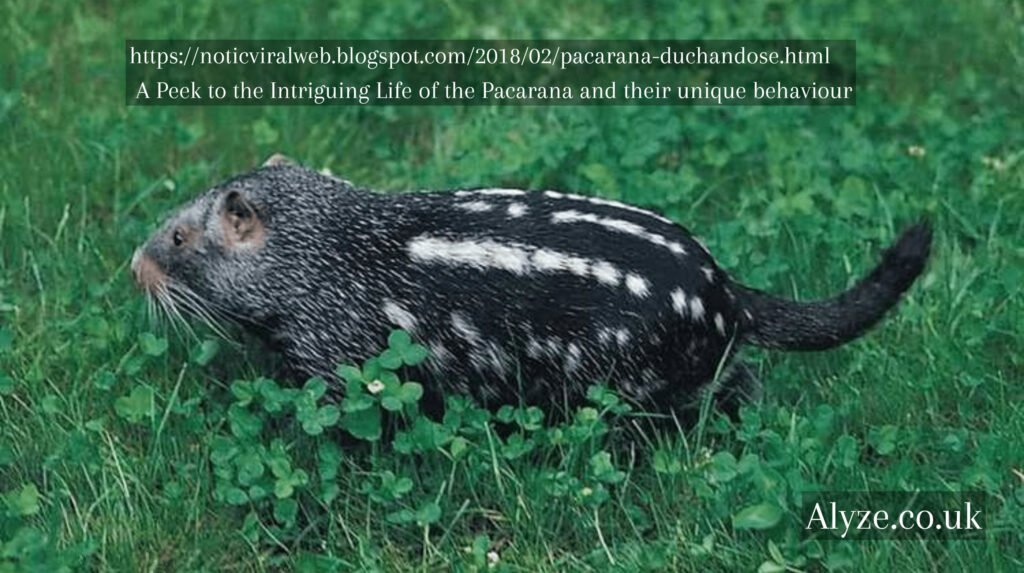Introduction
Of the wide variety of wildlife, some creatures gain many individuals’ attention due to their rather interesting behaviors and independent characteristics. One such outstanding creature is the Pacarana, a large rodent thathelms from South America. This article, shall aim to explore an interesting trait about the Pacarana showering one of the rare behaviors observed from this genus of rodent. We hope to be able to give an in-depth look at this fascinating animal, imbuing our readers with the knowledge herein.
Also Read : discount code ttweakairline : Unlocking the Secrets of TTWeak Airline Discount Codes and its Best Deals
The Pacarana: A General View.
Giant Among Rodents
The Pacarana is considered one of the biggest rodents in the world and belongs to the species Dinomys branickii. It is usually found in the tropical rainforest of South America, particularly in such countries as Brazil, Bolivia, Peru, and Colombia. Information obtained from nature reveals that it is a night creature and is characterized as quite a friendly animal with some rather weird habits. Its large size up to 15 kg (33 lbs) but that does not prevent the pacarana from being a herbivorous mammal feeding on fruits, leaves, and stems.
Distinct Behavioral Characteristics
One of the most interesting habits of the Pacarana is its propensity to indulge in what can only be described as “showering.” The Pacarana cleans itself in a style as if they are showering which is extremely different from other rodents which cleans itself with their paws or tongue. This unique trait not only speaks about their intelligence but also adds to its degree of charm and charisma.
The showering behavior of pacaranas.
How Pacaranas Shower
The Pacarana bathes by finding a stream, pool, or any small body of water, then using its front paws to splash water all over its body. It is not an aimless frolic; rather, it is self-conscious behavior in keeping itself clean. This seems to be some sort of pleasurable activity to the Pacarana, as it may spend as long as several minutes ensuring that it has cleaned every single hair on its coat. It is an unusual behavior in rodents and helps set the Pacarana apart from most of its relatives.
Significance of the Behavior
https://noticviralweb.blogspot.com/2018/02/pacarana-duchandose.html
This showering behavior has several functions. Majorly, it helps the Pacarana to remain clean and free of parasites. Further, it would thermoregulate the animal and lower its body temperature in the humid and warm environments prevailing inside the rainforest. Thus, such behaviour in a rodent gives much insight into their adaptiveness and intelligence.
Ecology and Habitat of Pacaranas
Natural Habitat
They do well in dense tropical rainforests of South America. They love areas that have dense vegetation, serving both food and shelter to them. This area of their dwelling is relatively rich in biodiversity; hence, it avails various numbers of plants for the Pacarana to feed on and several hideouts, which they use while running away from predators.
Role in the Ecosystem
https://noticviralweb.blogspot.com/2018/02/pacarana-duchandose.html
Being herbivores, Pacaranas are essential agents in the ecosystem. They spread seeds around, hence propagating the different plant species, and generally maintain the balance of vegetation in their habitat. In eating leaves and stems, they prevent overgrowth that might have a cascading effect on the balance of the forest’s ecological system.
Conservation Status and Challenges
https://noticviralweb.blogspot.com/2018/02/pacarana-duchandose.html
Current Status of Conservation
Although very fascinating, pacaranas are vulnerable, as noted in the IUCN Red List. Their populations are threatened by habitat loss resulting from deforestation and encroachment. Such wonderful creatures should not be placed at risk of extinction; thus, conservation is key.
Efforts and Initiatives
There are several conservation programs in place to protect habitats of Pacaranas. These range from creating protected areas and promoting sustainable land-use practices to research studies that will better address the needs of the species. Another basic component of such efforts is raising awareness about the need for biodiversity conservation.
FAQs
Q. What is the normal life expectancy for a Pacarana?
A: In the wild, a Pacarana typically lives for about 10 years, while in captivity this may stretch to more years if optimum conditions are provided.
Q. Are Pacaranas social beings?
A: Generally, pacaranas are solitary creatures, although they can be seen in pairs during their mating season. They love to lead a lonely life; they are mostly active at night.
Q. How does a Pacarana communicate?
A: Pacaranas use a wide array of vocalizations, body language, and scent marking to convey information. Using these ways of communication, the pacaranas mostly make their claims on territory and relate to potential mates.
Q. Can pacaranas be domesticated?
A: While these are fascinating animals, the pacarana does not make an appropriate pet. This due to the very specialized needs it has for its habitat, and to the conservation status of the animal. It is best to admire these animals when in their natural habitat or with respect to responsible wildlife programs.
Conclusion
The Pacarana is just one of the many diverse and interesting life forms that exist on our fertile planet. The showering behavior of the Pacarana is not only astounding to science researchers or nature lovers but has another aspect to it: it reminds us of the need to protect such species. When we study about parcana and try to conserve them, we take one more step toward global efforts that is the preservation of biodiversity and ecological balance. The more we explore and marvel at nature, the more we should be dedicated to the preservation and protection of these magnificent creatures for future generations to see and appreciate.



